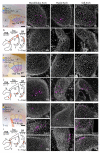Developmental evidence for serial homology of the vertebrate jaw and gill arch skeleton
- PMID: 23385581
- PMCID: PMC3600657
- DOI: 10.1038/ncomms2429
Developmental evidence for serial homology of the vertebrate jaw and gill arch skeleton
Abstract
Gegenbaur's classical hypothesis of jaw-gill arch serial homology is widely cited, but remains unsupported by either palaeontological evidence (for example, a series of fossils reflecting the stepwise transformation of a gill arch into a jaw) or developmental genetic data (for example, shared molecular mechanisms underlying segment identity in the mandibular, hyoid and gill arch endoskeletons). Here we show that nested expression of Dlx genes--the 'Dlx code' that specifies upper and lower jaw identity in mammals and teleosts--is a primitive feature of the mandibular, hyoid and gill arches of jawed vertebrates. Using fate-mapping techniques, we demonstrate that the principal dorsal and ventral endoskeletal segments of the jaw, hyoid and gill arches of the skate Leucoraja erinacea derive from molecularly equivalent mesenchymal domains of combinatorial Dlx gene expression. Our data suggest that vertebrate jaw, hyoid and gill arch cartilages are serially homologous, and were primitively patterned dorsoventrally by a common Dlx blueprint.
Figures





References
-
- de Beer G. The development of the vertebrate skull. Oxford University Press; 1937.
-
- Janvier P. Early Vertebrates. Clarendon; 1996.
-
- Gegenbaur C. Elements of comparative anatomy. MacMillan and Co.; 1878.
-
- Gai Z, Donoghue PC, Zhu M, Janvier P, Stampanoni M. Fossil jawless fish from China foreshadows early jawed vertebrate anatomy. Nature. 2011;476:324–327. - PubMed
-
- Shigetani Y, et al. Heterotopic shift of epithelial-mesenchymal interactions in vertebrate jaw evolution. Science. 2002;296:1316–1319. - PubMed
Publication types
MeSH terms
Substances
Grants and funding
LinkOut - more resources
Full Text Sources
Other Literature Sources

